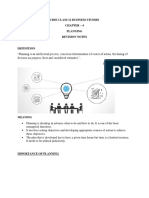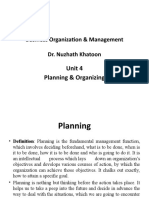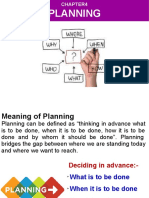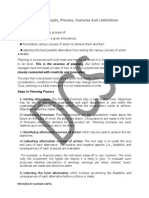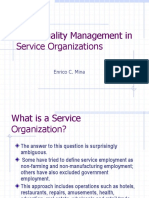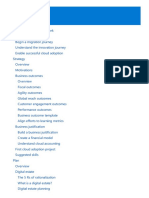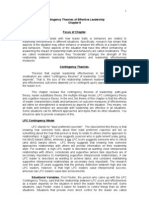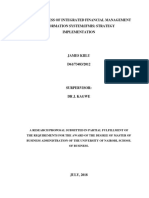PLANNING 5. Planning is Futuristic: The goal of 3.
Identifying Alternative Courses of
planning is to efficiently meet future Action: All the alternative courses of
Meaning - Planning entails deciding what to occurrences to an organization's action are identified.
accomplish and how to accomplish it ahead of time. benefit 4. Evaluating Alternative Courses of
It is a fundamental managerial function. 6. Planning Involves Decision Making: Action: Positive and negative
Choosing among a variety of options aspects of each alternative is
establishing goals and devising strategies for achieving
and activities is the essence of evaluated.
them.
planning. There is no need to plan if 5. Selecting the Best Alternative: The
Importance of Planning there is just one conceivable aim or alternative which is most feasible,
course of action because in that case profitable and with least negative
1. Planning provides direction-Planning provides no planning or decision making is consequences is selected as plan.
guidance for action by defining how the task required. 6. Implementing the Plan: The
will be done in advance. It ensures that goals 7. Planning is a Mental Exercise: selected plan is put into action.
are clearly specified so that the best course of Planning necessitates the use of the 7. Follow Up Action: In case of any
action may be devised. Once the strategies are mind and foresight deviations, changes are made in the
in place, the department and individuals may plans.
work together. Limitations of Planning
2. Planning Reduces the Risk of Uncertainty- The Types of Plan
paragraph emphasizes that planning is a crucial 1. Planning Leads to Rigidity: A well- 1. Single Use Plan and standing
management task that enables foresight and defined plan is drawn up in an plans: A single- use plan is
prediction of future changes. While changes and organization with specified goals to developed for a one-time event or
events are inevitable, effective planning allows be reached within a specific time project. A standing plan is used for
managers to anticipate them and adjust frame, but managers may not be activities that occur regularly over
strategies in advance by making informed able to amend it. a period of time.
decisions and outlining courses of action. 2. Planning May Not Work in a 2. Objectives: Objectives are the
3. Planning Reduces Overlapping and Wasteful Dynamic Environment: Planning is desired outcomes that
Activities: The basis for coordinating the actions based on anticipating future management hopes to attain
and efforts of several divisions, departments, events, and because the future is through its activities
and individuals is planning. It eliminates unpredictable and dynamic, the 3. Strategy: Strategy refers to long-
ineffective and unnecessary activities, prevents organization must react to changes term decisions that define an
misunderstandings, and assures clarity of 3. Planning Reduces Creativity: Top organization's direction and scope.
thinking and action. management plans and 4. Policy: Policies are general
4. Planning Promotes Innovative Ideas: The first intermediate management statements that guide thinking or
role of management is planning. Managers are executes the plan, but they are not channelise energies towards a
given the opportunity to generate fresh ideas, allowed to depart from the plan, particular direction.
which can then be turned into tangible limiting the creativity of these 5. Procedure: Procedures are step-by-
strategies. It directs all future actions that will managers. step instructions that specify how a
lead to the company's growth and prosperity. 4. Planning Involves Huge Costs: The task should be completed.
5. Planning Facilitates Decision Making: Setting plan's formulation entails a 6. Rule: Rules are specific statements
goals and forecasting future situations are all significant financial investment. To that specify what should and
part of planning, which aids in making sensible determine data, detailed strategies should not be done in situations.
judgments among various options. necessitate scientific computations 7. Method: Methods describe the
6. Planning Establishes Standards for Controlling: 5. Planning is Time Consuming: prescribed ways or manners in
Planning establishes the benchmarks against Many factors must be considered which a work can be completed
which actual performance is assessed. As a when developing a strategy, considering the goal.
result, planning is a must for controlling. making it a lengthy process. 8. Programme: A programme may
6. Planning Does Not Guarantee include a complete list of project
Features of Planning Success: Only carefully planned and objectives, policies, processes,
implemented plans can lead to the regulations, tasks, and the physical
1. Planning Focuses on Achieving Objectives:
success of a business. Managers and human resources needed to
Organizations are formed with a certain goal in
are prone to implementing carry out any course of action
mind. The goals, general and specific as well as
previously successful ideas, but a 9. Budget: A budget is a statement of
the strategies and activities to attain these
plan that worked in one context expected results expressed in
goals, are established by organizations under
may not work in another. numerical terms. It is a plan which
the planning function
quantifies future facts and figures.
2. Planning is a Primary Function of Planning Process
Management: Planning lays the groundwork
for all other management tasks, without 1. Setting Objectives: Objectives may
planning no other function can take place. be set for the entire organisation
3. Planning is Pervasive Planning is required in all and each department/ unit within
types of organizations, at all the levels of the organisation.
management, as well as all the departments 2. Developing Premises: Because
within the organization planning is a future-oriented activity
4. Planning is Continuous: The planning cycle is and the future is uncertain,
linked to planning continuity. It indicates that a managers must make certain
strategy is devised, implemented, and then assumptions while creating
followed by another strategy, and so on. organizational plans.













